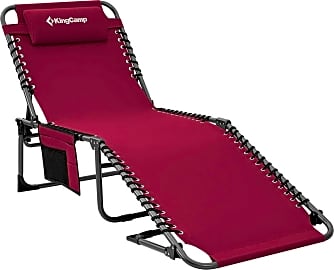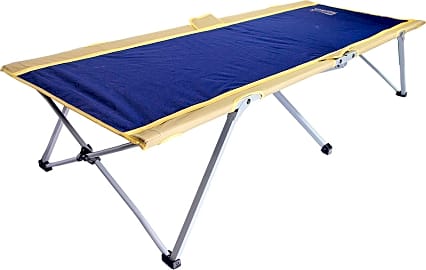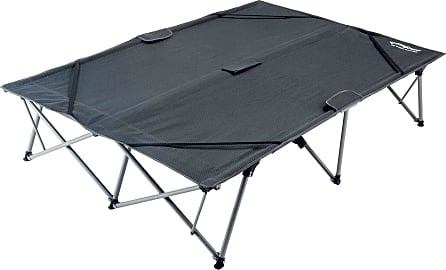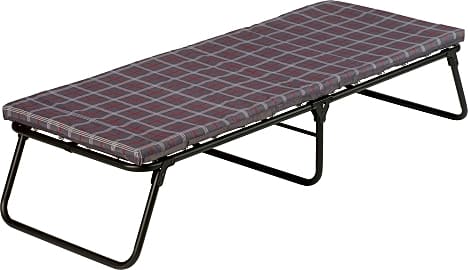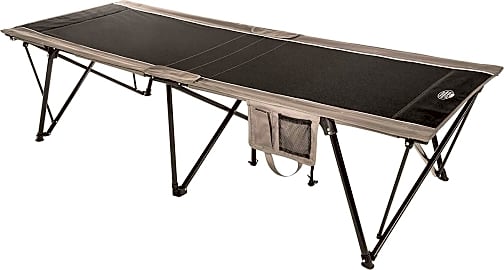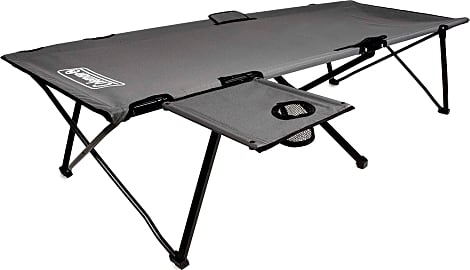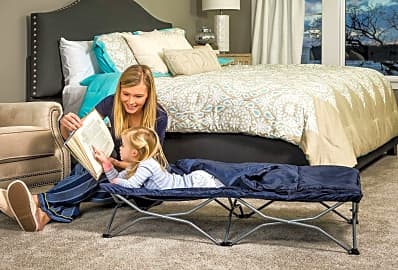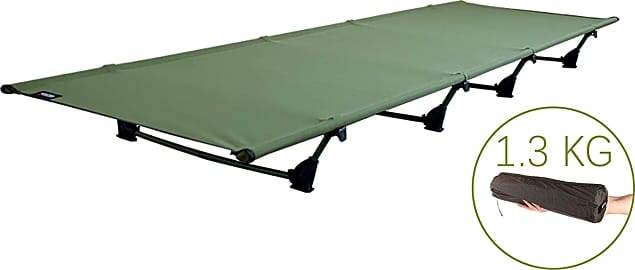The 10 Best Camping Cots

This wiki has been updated 39 times since it was first published in April of 2015. Just because you're heading into the wilderness for a few days, it doesn't mean you have to roll around on a cold, hard, dirty floor all night long. Add a little luxury and comfort to your outdoor excursions with one of these camping cots. We've selected models that'll improve your overall experience, so you'll be well rested and refreshed for all the adventures your trip may throw at you. When users buy our independently chosen editorial selections, we may earn commissions to help fund the Wiki.
Editor's Notes
December 14, 2020:
In our latest update, we removed the Mountain Trails Base Camp due to availability concerns and replaced it with the KingCamp Double. The KingCamp Double comfortably fits two people for those who are going to be sharing their cot. You can also use it with an air mattress for an extra comfortable night sleep.
We also replaced the KingCamp Deluxe with the KingCamp Adjustable. While the KingCamp Deluxe has an adjustable head, the KingCamp Adjustable is an even more versatile option because it has three position settings. With this pick, you can either be lounging, sitting up, or lying completely flat. This would be an ideal choice for folks that appreciate a minimal packing list.
April 29, 2019:
Choosing the right camping cot can seem a little stressful, because a poor night of rest can ruin a trip quickly. But we still believe that for most people, the Teton Sports Outfitter, the KingCamp Deluxe, and the Byer of Maine EasyCot all offer the comfort necessary for a decent night of dreaming. One caveat about the KingCamp Deluxe, however: while nearly everyone loves the angled head, some users find that it causes them to slide down as they sleep. We'd suggest that with this model, a test nap is a good idea, so you can find the most comfortable configuration. We also still think the Disc-O-Bed Large is a fine option, but its size and cost will prevent it from being the right choice in all situations. On the other end of the spectrum, we like the Desert Walker Lightweight, which weighs in at a mere 3 pounds. Not everyone will want to take a cot on a backpacking trip, but for those who do, this is one to consider. Finally, we removed the Texsport King Giant, as the fabric is just too prone to ripping, and the World Outdoor Products Big Bear, which suffers from availability issues.
The Luxury Of Sleeping Anywhere
Each of these units is designed to produce the most comfort possible from as simple a device as you could imagine.
I've often bragged about my ability to sleep anywhere, any time, on any surface. I've slept on gravel in the blazing sun, on cold slabs of concrete in the dead of winter, even on a set of grated metal stairs in a dusty, noisy factory space. Sometimes the talent gets out of hand, like when I'm driving long distances and I start to fade, necessitating a quick stop by the roadside for a 20-minute nap before I continue.
I understand that not everyone is as blessed (cursed?) as I am in this regard, and that finding a comfortable and safe way to fall asleep in a difficult setting presents a challenge to most folks.
That's where these camping cots come in. Each of these units is designed to produce the most comfort possible from as simple a device as you could imagine. They pack up into small, usually lightweight packages for transport through a rough hike or road trip.
The idea itself is pretty simple: it's a piece of fabric stretched out across a series of supporting legs. Usually, the legs cross each other to create a triangle with the ground, which adds immense stability to the cot, and they recur down its length so that stability is evenly distributed, preventing any one part of the cot from sagging more than another. You get yourself a solid, even surface that will support your weight and quickly carry you off to the land of nod.
The fabric stretched between the supports is usually a thick canvas, which is naturally water-resistant and treated for further durability, though some cots use synthetic materials that claim greater staying power and lighter weights than most canvas mats.
Sleep Easiest: Choosing The Best Camping Cot
In order to select the best cot for your needs, it's important that you consider the environment in which you plan to use it. If you're planning a trip deep into the wintry woods with not much more than a good knife, a bow and arrow, and a few water purification tablets, then you're probably the type who doesn't put comfort at the forefront of your wilderness sleeping decisions. If, on the other hand, your idea of a walk on the wild side involves a large, late-model RV; several cooler's worth of caviar and foie gras; and the word 'glamping,' then your camping cot will have to be the most comfortable thing on our list.
What makes one camping cot more comfortable than another has to do with the quality of its surface material, the layout of its frame, and its size and weight capacity.
Pay close attention to size and weight restrictions, as well.
Most camping cots consist of three primary support structures, one at each end in addition to a central support. This configuration places its central beam around the lumbar area in the majority of sleeper' backs, making it about as comfortable as possible while maintaining a system that can easily collapse for portability in the wilderness. Additional supports may decrease the amount of sag points on your sleeping surface, but they also might create protrusions in uncomfortable areas, such as the thighs or upper back. Some models boast no additional support beyond the ends to which your surface affixes, and this configuration is often found on more expensive models made with non-traditional surface materials that are less likely to sag over time.
Pay close attention to size and weight restrictions, as well. Some cots are simply not made for the big and tall among us. Most people only consider cot length when discussing size, and, while the length of a cot is certainly a vital aspect of its comfort, so, too, is its width. If your cot accommodates your body head-to-toe, but fails to meet the demands of wide-set shoulders, you could be in for a long night.
Similarly, just because a cot is advertised to support your weight, that doesn't mean it will do so comfortably. Try to find a cot that's built to support a great deal more than whatever it is you weigh. A cot rated to hold 300 lbs. would be plenty comfortable for someone who only weighs 185, but it might not rock a 290 lb. camper off to sleep so easily. As an added bonus, buying a cot that far exceeds your current weight will future-proof it against any gradual slowing of your metabolism.
A Brief History Of The Camping Cot
When people think of cots, the traditional image is one of a sheet of military-green canvas stretched out between two x-shaped supports. The association between cots and the military is no coincidence, as the likeliest creator of the modern cot was the Roman military.
The association between cots and the military is no coincidence, as the likeliest creator of the modern cot was the Roman military.
There are plenty of examples throughout history of the ways in which human sleep evolved along with our agricultural domestication, from piles of filthy hay more than 10,000 years ago and the more sophisticated apparatuses of Native American tribes to the inflatable monsters owned by modern glampers, but the cot in its most recognizable form comes to us from that great Mediterranean empire.
The Romans were known for developing a slew of military innovations, including segmented armor and a device called a corvus, which was a retractable bridge with a large metal spike on its boarding end that stuck into the hull of enemy ships and allowed soldiers to cross over and seize the vessel. Despite these mechanisms of active warfare, it was the Romans' use of sophisticated tents and cots that gave their fighters the added advantage of a good night's sleep.
Still, cots didn't serve much of a recreational purpose until some time after the second world war. In the 1960s and 70s, as the greatest generation first started settling down into retirement, all that leisure time led to an increase in outdoor activities, from camping and skiing to mountain biking and surfing. The 1970s saw a significant uptick in the development of camping gear, as well as the introduction of new outdoor sports. As the 80s rolled on, advancements in materials design gave us enhanced waterproofing and overall durability in our tents, backpacks, and cots, leading to the enormous assortment of high-priced, durable outdoor goods available today.


